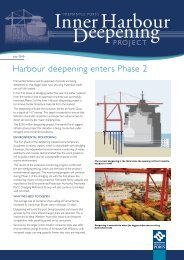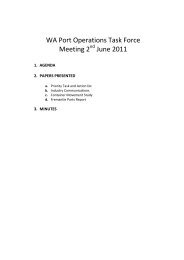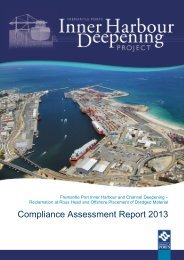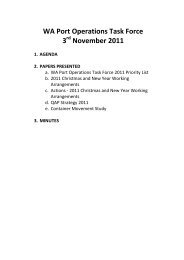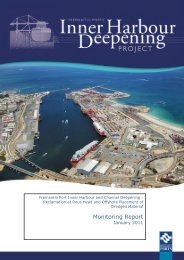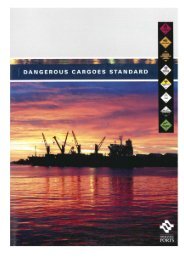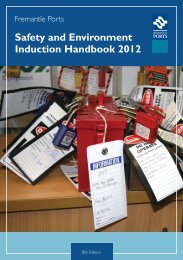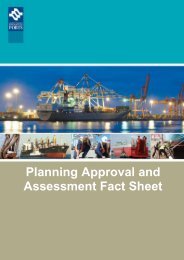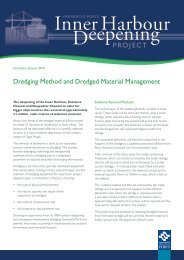Fremantle Port Inner Harbour and Channel ... - Fremantle Ports
Fremantle Port Inner Harbour and Channel ... - Fremantle Ports
Fremantle Port Inner Harbour and Channel ... - Fremantle Ports
- No tags were found...
Create successful ePaper yourself
Turn your PDF publications into a flip-book with our unique Google optimized e-Paper software.
Executive SummaryOceanica Consulting Pty Ltd (Oceanica) has been engaged by <strong>Fremantle</strong> <strong>Port</strong>s to investigatethe rate <strong>and</strong> controlling mechanisms of Posidonia angustifolia (Cambridge <strong>and</strong> Kuo) seagrassrecovery within <strong>and</strong> surrounding the Gage Roads Offshore Disposal Area, subsequent to the<strong>Inner</strong> <strong>Harbour</strong> <strong>and</strong> <strong>Channel</strong> Deepening (IHD) Project undertaken between January <strong>and</strong>October 2010. This report describes an initial (Phase I) survey of seagrass health, coverage<strong>and</strong> coincident sediment physicochemical data within <strong>and</strong> surrounding the Offshore DisposalArea. This data comprises a 'baseline' for a medium term (up to 3 years) investigation intoseagrass recovery. This report also collates relevant historical data <strong>and</strong> outlines methodsused for the Phase I survey, further intended for subsequent surveys to ensure a consistentst<strong>and</strong>ard operating procedure for future assessment of seagrass recovery.The specific objectives of the initial Phase I survey, within <strong>and</strong> immediately surrounding theOffshore Disposal area, were to:1. Define the spatial extent of seagrass habitat;2. Determine seagrass health, as indicated by P. angustifolia shoot density <strong>and</strong> percentagecover, within "undisturbed", "transitional" <strong>and</strong> "disturbed" zone specific sites; <strong>and</strong>3. Assess the sediment chemistry <strong>and</strong> physical characteristics of coincident sites, to enablespatial assessment of potential physicochemical controls on seagrass health.A benthic habitat map was created using a satellite image <strong>and</strong> towed video ground-truthingdata to delineate the present spatial extent of seagrass within <strong>and</strong> surrounding the OffshoreDisposal Area. A decline in seagrass habitat of 19.9 ha was estimated in <strong>and</strong> adjacent to theOffshore Disposal Area, following the IHD Project. The majority (76%) of seagrass habitatloss occurred in the Offshore Disposal Area.Based on the ground-truthing data, fifteen permanent seagrass monitoring sites were set upin November 2011 surrounding the Offshore Disposal Area; with five sites in eachundisturbed, transitional <strong>and</strong> disturbed zone. These permanent sites have all been placed inlocations where seagrass habitat existed prior to sediment disposal in depths of 18-21 m.Site determination consisted of semi-qualitative methods of towed video to selectundisturbed, transitional <strong>and</strong> disturbed seagrass areas, within which monitoring sites wereestablished based on initial survey data of seagrass percentage cover <strong>and</strong> shoot density. Thisdetermination process created a robust three zone experimental design, capable of capturingchanges in P. angustifolia cover <strong>and</strong> shoot density. 'Undisturbed’ seagrass sites were locatedoutside, but within 1600 m, of the Offshore Disposal Area. Transitional sites had seagrasscover which appeared impacted by dredging material, but not drastically disturbed.Disturbed sites were located at the fringe of the transitional areas with low seagrass coverage<strong>and</strong> adjacent to barren areas with apparent deposition of dredge materials.The Phase I survey demonstrated that undisturbed sites of P. angustifolia had a mean shootdensity (257-407 shoots per m 2 ) that was within the range of natural seasonal variationrecorded from the three sites previously monitored for the IHD Project (284-732 shootsper m 2 ; Oceanica 2010a). Statistically significant differences were found amongst zones(undisturbed, transitional <strong>and</strong> disturbed) for both seagrass percentage cover <strong>and</strong> shootdensity. The percentage cover <strong>and</strong> shoot density of seagrass was: highest at undisturbedsites (34-67%; 257-407 shoots per m 2 ); lowest at disturbed sites (4-22%; 12-240 shoots perm 2 ); <strong>and</strong> intermediate at transition sites (17-27%; 100-293 shoots per m 2 ).Multivariate analysis of whole sediment nutrients <strong>and</strong> metals suggested that no combinationof chemical analytes was controlling the percentage cover or density (i.e. 'health') ofP. angustifolia. Further, nutrient concentrations in pore-waters were not statistically differentamongst zones (undisturbed, transitional <strong>and</strong> disturbed). Total organic carbonconcentrations of sediments were very low (



